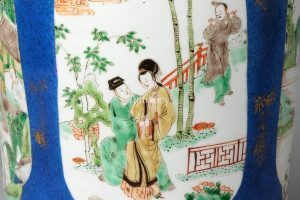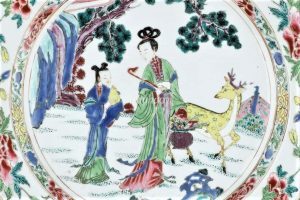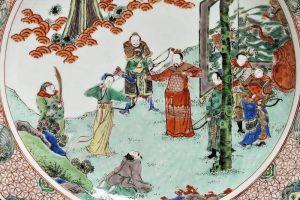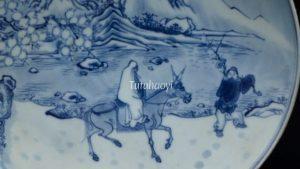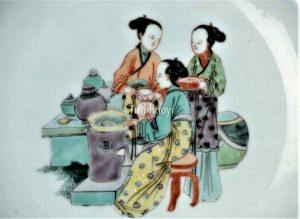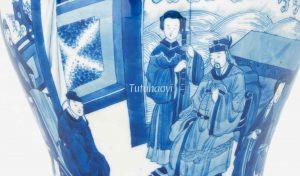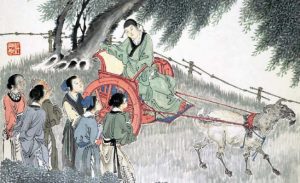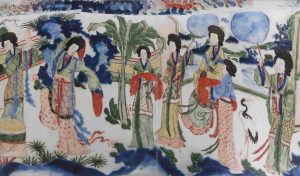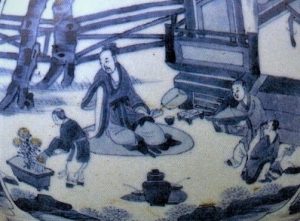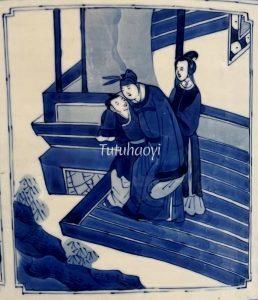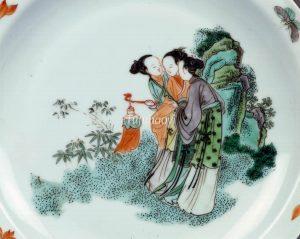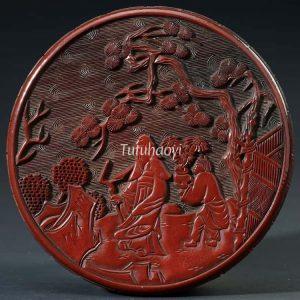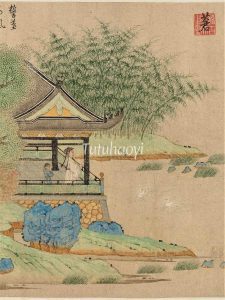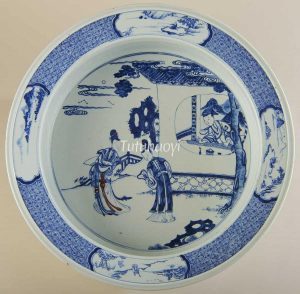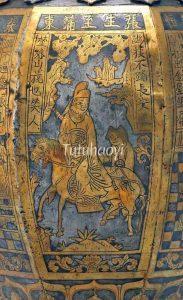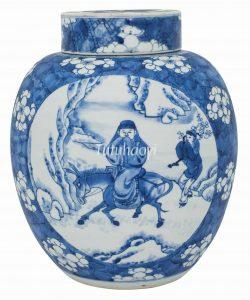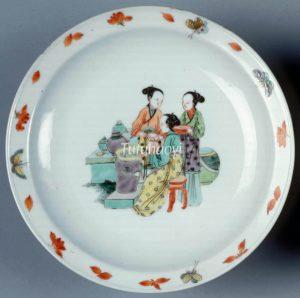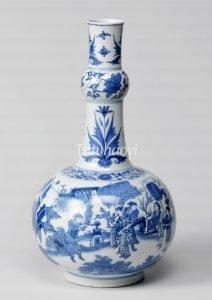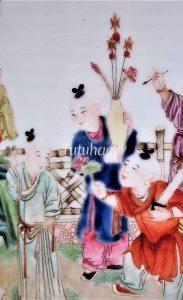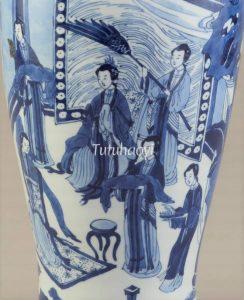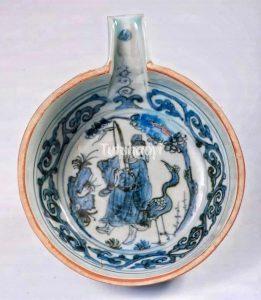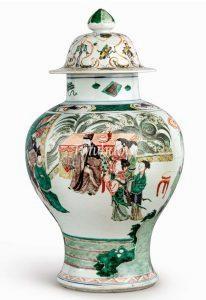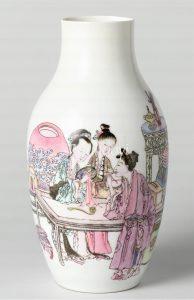Showing Results Containing
Have you ever wondered why the image of the prunus has been a popular motif in Chinese decorative art? Why do Chinese literati love to write poems about plum blossoms and paint them in their art works? Dr Yibin Ni will explain to you the symbolic ...
‘Imperial Consort Lady Yang Getting Drunk’ has been a popular Chinese story plot since the seventeenth century. However, many renowned museums are still not able to identify this story scene on the porcelains in their collection. Dr Yibin Ni will ...
The story scene comes from a marvel play Legend of the Jade Hairpin, which is not to be confused with the scene in Romance of the Western Chamber. Read the following article to find out details of the story and how this figural scene is depicted.<...
Chinese people deeply respect the elderly and traditionally consider a long existence to be one of the most important blessings in a person’s life. Here are many examples of how artists have combined a variety of longevity symbols to reinforce the...
Congratulations on art historian Dr Yibin Ni’s new research into a rare story scene in Chinese pictorial art, which may have puzzled contemporary museum curators and porcelain collectors. Dr Ni has traced the art historical context in which this r...
A literati theme with the image of a scholar riding in a snowscape with branches of plum blossoms in the vicinity has been very popular in traditional Chinese visual culture and literature. But who is the scholar in the scene? Art historian Dr Yib...
Pictorial artworks with figural scenes in traditional China often have historical and cultural significance and are not to be mistaken for daily life genre painting. Here is an example and Dr Yibin Ni will explain to you the hidden meaning in the ...
Have you ever been puzzled by the description of ‘figural paintings’ for Chinese porcelains listed by various museums and auction catalogues? In fact, many Chinese paintings with figures refer to ancient stories and have meanings behind the scenes...
Have you wondered why the same story scenes were painted differently on Chinese artworks? How was it painted to present women falling in love on Chinese antique porcelains? Read on to see what Dr Yibin Ni has to say with his analysis.
Do you wonder why there is a goat drawing a carriage, rather than a horse, on traditional Chinese art pictures? Why are there so many people watching someone in a chariot? What is the story behind it? Here is what Dr Yibin Ni has to tell you.
This is an overview by Dr Yibin Ni on how the topic of ‘The Birthday Party of the Queen Mother of the West’ was depicted on Chinese artworks, from woodblock print during Ming dynasty to scroll painting and porcelains in Qing dynasty.
Images of Tao Yuanming Appreciating Chrysanthemums, like many other traditional historical themes, are often mistaken as a mere ‘flowering-picking’ scene, or, worse, simply a ‘figure painting’. Let’s see an example.
This story scene originates from one of the four famous romantic plays in Yuan dynasty, Pei Shaojun on horseback meeting Li Qianjin over the garden wall (also known as On Horseback and over the Garden Wall) 裴少俊墙头马上, which was written by playwright Bai Pu (白朴 1226 – after 1306).
Pei Shaojun ...
This is Scene Four of Act Two of the Chinese classic popular drama Romance of the Western Chamber (西厢记 Xixiang Ji), written by the Yuan playwright Wang Shifu (1250–1336).
Madame Cui and her daughter Cui Yingying 崔莺莺 were residing temporarily in the monastery where Zhang Junrui’s (张君瑞, also called Scholar ...
The play Polishing the Dust-covered Mirror (磨尘鉴 Mo Chen Jian) was compiled in 1619 by an obscure playwright Niu Ge (钮格), according to some twentieth-century researchers, including the eminent scholar of the field Zheng Zhenduo (郑振铎 1898–1958). The play portrays some colourful historical figures of the T...
Tao Yuanming (陶渊明, 365–427), also known as Tao Qian 陶潜, the paragon of ‘Fields and Gardens poetry’, spent most of his life as a hermit in a cottage in the countryside, reading, drinking wine, and writing poetry in an unmannered style. He had a unique eye for the beauty and serenity of the natural world c...
Pun Design :
Official Hat + Wine Vessel
Punning Details:
The combination of ‘jia 加 putting on’ and ‘guan 冠 hat’ – ‘jia guan 加冠’ is a pun on ‘jia guan 加官’, meaning ‘receiving an official title...
Legend of the Jade Hairpin (Yu Zan Ji 玉簪记) is a Ming-dynasty ‘marvel play’ which was the major drama genre of the time. The play, consisting of thirty-three scenes, was written by Gao Lian (高濂 fl. 1573-1581) around 1580 and remained to be a popular classic for the following three hundred years. It is a Shakespea...
Wang Xizhi (王羲之, 303–361) is often said to be the greatest calligrapher in Chinese history. He has his biography in the official history of Jin 晋 dynasty (c. 265–420). One anecdote in it concerns his fame for his calligraphic skill and his love of geese. A Daoist priest in the neighbourhood raised a handsome flock of gee...
This is Scene Five of Act Two of the Chinese classic popular drama Romance of the Western Chamber (西厢记 Xixiang ji).
At a family dinner party, Zhang Junrui’s (张君瑞, also called Scholar Zhang 张生) dream of marrying Yingying (莺莺) the love of his life was shattered by Yingying’s mother because he was a nobody w...
Young scholar Zhang Junrui (张君瑞, also called Zhang Sheng 张生) is the male protagonist in the famous ancient Chinese play, Romance of the Western Chamber (西厢记 Xixiang j...
Meng Haoran (孟浩然, c. 690–740) is one of the most renowned poets in Tang dynasty (618–906). He started off pursuing a civil service career and then abandoned it to concentrate on poetry. He was a major influence on other Tang and later poets because of his innovative focus on nature. There is a play attributed to the note...
‘Diao Mei He Geng 调梅和羹’ is a metaphor that likens the art of governing a country to the adequate seasoning of a stew with salt and sour prunes. The scene is often made up of a group of women or men surrounding a stove, on which a cauldron of food is being cooked, with an assistant holding a container with sour p...
Evidently, Zhao Kuangyin (赵匡胤 927–976), Emperor Taizu of the Song dynasty (宋太祖), often paid unofficial surprise visits to his courtiers. As a result, his ministers did not dare to change their official attire into casual wear even when they returned home from court. They had to be ready for imperial visits any time and d...
The main figure in the scene is a dignitary, often gripping a hu (笏) tablet in his hands, which an official uses to take notes when he has audience with the emperor in court. He is usually sheltered by page boys erecting some fans or a parasol or guarded by a soldier holding a weapon with an iron melon on the to...
A variation of 平升三级 ping sheng san ji (May you have three successive promotions unexpectedly) is 连升三级 lian shen...
Wang Zhaojun (王昭君, c.52 – c.15 BCE) was one of the court ladies in the harem of Emperor Yuan of the Western Han dynasty (汉元帝, 206 BCE – 8 CE). It was not possible for the emperor to meet every one of the three-thousand concubines, so he had a court painter paint their pictures to facilitate his selection proc...
In Zhuangzi (庄子), an ancient Chinese text from the late Warring States period (476–221 BCE) and one of the two foundational texts of Daoism, the Queen Mother of the West (Xiwangmu 西王母) was mentioned as a deity who ‘obtained the Dao (the Way)’. According to the Scripture of Great Peace (Tai...
Zhao Bian (赵抃, 1008–84) was held in high esteem all his life and posthumously because of his incorruptibility and sound statesmanship during his entire career. His prize possessions were legendarily well-known: a qin zither and two pets, a Continue Reading
With strategic plans to restore the war-torn country back to order, the talented scholar Li Jing (李靖) was paying a visit to the powerful Lord Yang Su (杨素), who enjoyed luxurious ways of living and female company around him. To Li Jing’s disappointment, Lord Yang did not take his plans seriously. However, Red Fly Whisk (红...
Zhang Chang (张敞, ?- 48 BCE) and his wife grew up in the same village. When they were both children, Zhang Chang once threw a pebble at his future wife and, unfortunately, the scratch left a scar on one of her eyebrows. Later, Zhang became a civil servant and learned that the girl he once hit with a pebble was unmarried b...


